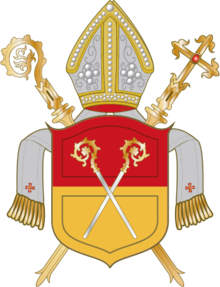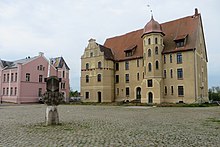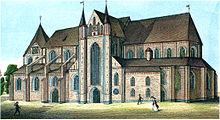This article has multiple issues. Please help improve it or discuss these issues on the talk page. (Learn how and when to remove these messages)
|

The Diocese and Prince-bishopric of Schwerin was a Catholic diocese in Schwerin, Mecklenburg, in Germany. The first registered bishop was ordained in the diocese in 1053, and the diocese ceased to exist in 1994.
Pre-Reformation Catholic (prince-)bishopric
The bishops of the Roman Catholic diocese of Schwerin (German: Bistum Schwerin), a suffragan of the Metropolitan Archdiocese of Bremen, were simultaneously secular (political) rulers of princely rank (prince-bishop) in the Prince-Bishopric of Schwerin (Hochstift Schwerin); established 1180 and secularised in 1648), an imperially immediate state of the Holy Roman Empire. Schwerin was the seat of the chapter, Schwerin Cathedral and residence of the bishops until 1239. In 1180 a prince-episcopal residence was established in Bützow, which became the main residence in 1239.
Titulature of the Schwerin bishops
Not all incumbents of the Schwerin see were imperially invested with princely temporal power as Prince-Bishops and not all were papally confirmed as bishops. In 1180 part of the Schwerin diocesan territory was disentangled from the Duchy of Saxony and became an own territory of imperial immediacy called Prince-Bishopric of Schwerin, an imperially immediate feudal member state of the Holy Roman Empire like many prince-prelatures.


The prince-bishopric was an elective monarchy, with the ruling prince being the respective bishop usually elected by the Cathedral chapter, and confirmed by the Holy See, or exceptionally only appointed by the Holy See. Papally confirmed bishops were then invested by the emperor with the princely regalia, thus the title prince-bishop. However, sometimes the respective incumbent of the see never gained a papal confirmation, but was still invested the princely regalia. Also the opposite occurred with a papally confirmed bishop, never invested as prince. A number of incumbents, elected by the chapter, neither achieved papal confirmation nor imperial investiture, but as a matter of fact nevertheless de facto held the princely power. From 1532 to 1648 all incumbents were Lutherans.
The respective incumbents of the see bore the following titles:
- Bishop of Mecklenburg until 1162
- Bishop of Schwerin 1162 to 1181
- Prince-Bishop of Schwerin from 1181 to 1516, except o the years of 1474 to 1479 and 1506 to 1508
- Administrator of the Prince-Bishopric of Schwerin 1474 to 1479, 1506 to 1508, and again 1516 to 1648. Either simply de facto replacing the Prince-Bishop or lacking canon-law prerequisites the incumbent of the see would officially only hold the title administrator (but nevertheless colloquially referred to as Prince-Bishop).
Catholic bishops of Mecklenburg and Schwerin (1053–1181)
| Catholic Bishops of Mecklenburg and Schwerin (1053–1181) | |||||
| Episcopate | Portrait | Name | Birth and death with places |
Reason for end of office |
Notes |
|---|---|---|---|---|---|
| 1053–1066 | John Scotus as John I |
*approx. 990 – 10 November 1066* | death | martyr, sacrificed by pagans to Radegast | |
| 1066–1148 | sede vacante | the diocese was abandoned after the Wendish uprising | |||
| 1148–1162 | Eberhard also: Emmehard |
||||
| 1162–1191 | Berno of Amelungsborn |
*unknown – 14 January 1191* | death | Apostle of the Obotrites, gained princely power in part of his diocese by 1181 on the carve-up of Saxony | |
Catholic Prince-Bishops (1181–1474)
| Roman Catholic Prince-Bishops of Schwerin (1181–1474) | |||||
| Reign and episcopate | Portrait | Name | Birth and death with places |
Reason for end of office |
Notes |
|---|---|---|---|---|---|
| 1162–1191 | Berno of Amelungsborn |
*unknown – 14 January 1191* | death | Apostle of the Obotrites, gained princely power in part of his diocese by 1181 on the carve-up of Saxony | |
| 1191–1238 | Brunward | ||||
| 1191–1195 | Hermann of Hagen |
anti-bishop | |||
| 1238–1240 | Frederick of Hagen as Frederick I |
||||
| 1240–1247 | Dietrich | ||||
| 1247–1249 | William | ||||
| 1249–1262 | Rudolph I | *unknown – 1262* | death | ||
| 1263–1291 | Hermann of Schladen as Hermann I |
||||
| 1292–1314 |  left image |
Godfrey von Bülow as Godfrey I (Bülow family) |
*unknown – 1314* | death | uncle of Henry I and Ludolph |
| 1315–1322 | Hermann von Maltzan as Hermann II |
||||
| 1322–1331 | Johann Gans zu Putlitz as John II (Gans zu Putlitz) |
||||
| 1331–1339 |  left image |
Ludolph von Bülow (Bülow family) |
*before 1298 – 23 April 1339*, Warin | death | nephew of Godfrey I, brother of the next, uncle of Frederick II |
| 1339–1347 |  right image |
Henry von Bülow as Henry I (Bülow family) |
*unknown – 1347* | death | brother of the former, nephew of Godfrey I, uncle of Frederick II |
| 1347–1348 | Willekin Pape | ||||
| 1348–1356 | Andrew of Wislica | ||||
| 1356–1363 | Albert of Sternberg German: Albrecht |
*c. 1333 – 14 January 1380*, Litomyšl | became Bishop of Litomyšl | also Bishop of Litomyšl (1364–1368, and again 1371–1380), Prince-Archbishop of Magdeburg (1368–1371) | |
| 1363–1365 | Rudolph of Anhalt as: Rudolph II (House of Ascania) |
*unknown – 1365*, Coswig in Anhalt | death | son of Albert II, Prince of Anhalt-Zerbst | |
| 1366–1377 |  right image |
Frederick von Bülow as: Frederick II (Bülow family) |
*unknown – 1366* | death | nephew of Ludolph and Henry I |
| 1377–1381 | Melchior of Brunswick and Lunenburg, Grubenhagen line (House of Welf) |
*1341 – 6 June 1384* | before Prince-Bishop of Osnabrück (1369–1375); rivalled in Schwerin by anti-bishop Marquard in 1377/1378 | ||
| 1377–1378 | Marquard Bermann | anti-bishop | |||
| 1381–1390 | John Potho of Pothenstein also: Pottenstein as John III |
*unknown – 1390* | death | before Prince-Bishop of Münster (1379–1382) appointed only, de facto he could not prevail over his rivals in Schwerin | |
| 1381–1388 | Johann Junge as John IV |
anti-bishop | |||
| 1381–? | Gerard of Hoya (Counts of Hoya) |
anti-bishop | |||
| 1390–1415 | Rudolf of Mecklenburg-Stargard as: Rudolph III (House of Nikloting) |
*unknown – 1415* | death | before Bishop of Skara (1387–1391), son of John I, Duke of Mecklenburg-Stargard | |
| 1416–1418 | Henry of Nauen as Henry II |
||||
| 1419–1429 | 
|
Henry of Wangelin as Henry III |
|||
| 1429–1444 | Hermann Köppen as Hermann III |
*unknown – 3 January 1444* | death | ||
| 1444–1457 | Nicholas Bödeker as Nicholas I |
||||
| 1458 | Godfrey Lange as Godfrey II |
||||
| 1458–1473 | Werner Wolmers |
||||
Catholic Administrators and Prince-bishops (1474–1532)
| Catholic Administrators and Prince-Bishops (1474–1532) | |||||
| Reign and episcopate | Portrait | Name | Birth and death with places |
Reason for end of office |
Notes |
|---|---|---|---|---|---|
| 1474–1479 | Balthasar of Mecklenburg (House of Nikloting) |
*1451 – 16 March 1507*, Wismar | resigned tired from pursuing investiture, turned secular | before Administrator of the Prince-Bishopric of Hildesheim (1471–1474); only administrator, never invested bishop; since duke in Mecklenburg-Schwerin, co-ruling with his brother Magnus II | |
| 1479–1482 | Nicholas of Pentz as Nicholas II |
||||
| 1482–1503 | 
|
Conrad Loste |
|||
| 1504–1506 | John Thun as John V |
||||
| 1504 | Reimar von Hahn (Hahn family) |
anti-bishop | |||
| 1506–1508 | Ulrich von Malchow | only administrator, never invested as bishop | |||
| 1508–1516 | Petrus Wolkow |
||||
| 1516–1522 | Zutpheld Wardenberg |
only administrator for the minor Magnus, also Dean (Domdechant) of Schwerin Cathedral | |||
| 1522–1532 | Heinrich Banzkow also: Banzcow or Bantzkow |
*before 1499–1540* | resigned when Magnus came of age | only administrator for the minor Magnus, never pursued investiture as bishop; also provost of Hamburg Cathedral | |
Due to the Reformation, the Catholic diocese was suppressed in 1555, without formal successor.
Lutheran Schwerin
Lutheran Administrators of the Prince-Bishopric (1532–1648)
| Lutheran Administrators of the Prince-Bishopric (1532–1648) | |||||
| Reign and episcopate | Portrait | Name | Birth and death with places |
Reason for end of office |
Notes |
|---|---|---|---|---|---|
| 1532–1550 | Magnus of Mecklenburg (House of Nikloting) |
Stargard, *4 July 1509 – 28 January 1550*, Bützow | death | bishop elect since 1516, due to minority only officiating since 1532 as administrator, due to lack of papal confirmation, Magnus introduced the Reformation in 1533 | |
| 1550–1603 | 
|
Ulrich of Mecklenburg as Ulrich I (House of Nikloting) |
Schwerin, *5 March 1527 – 14 March 1603*, Güstrow | death | grandfather of the next; also Duke of Mecklenburg-Güstrow (1555–1603) |
| 1603–1624 | Ulrik of Denmark as Ulrich II (House of Oldenburg) |
Koldinghus Palace, Kolding, *30 December 1578 – 27 March 1624*, Rühn | death | grandson of the former, uncle of the next; also Lutheran Bishop of Schleswig (1602–1624) | |
| 1624–1629 | 
|
Ulrik of Denmark as Ulrich III (House of Oldenburg) |
Frederiksborg Palace, Hillerød, *2 February 1611 - 12 August 1633*, Schweidnitz | resigned when his father Christian IV renounced posts held by his family in the Empire in 1629 (Treaty of Lübeck) | nephew of the former; since 1628 de facto deposed by Wallenstein's conquest of the prince-bishopric |
| 1629–1634 | sede vacante | territory of the Prince-Bishopric was part of Wallenstein's duchy of Mecklenburg | |||
| 1634–1648 | 
|
Adolf Frederick of Mecklenburg (House of Nikloting) |
Schwerin, *15 December 1588 – 27 February 1658*, Schwerin | prince-bishopric transformed into principality by Peace of Westphalia | also Duke of Mecklenburg-Schwerin as Adolphus Frederick I
(1592–1628, and again 1631–1658) |
| after 15 May 1648 | The Prince-Bishopric was converted into a heritable monarchy, the Principality of Schwerin, ruled in personal union by the House of Nikloting in Mecklenburg-Schwerin. | ||||
Lutheran Regional Bishops of Mecklenburg since 1921

When the Grand dukes of Mecklenburg-Schwerin and Mecklenburg-Strelitz abdicated, the Lutheran state churches became independent and adapted their new Church Orders, providing for a function called Landesbischof (state bishop). In 1934 the regional churches merged into the Evangelical Lutheran Church of Mecklenburg.
- 1921–1933: Gerhard Tolzien (for the Church of Mecklenburg-Strelitz)
- 1921–1930: Heinrich Behm (for the Evangelical Lutheran Church of Mecklenburg-Schwerin)
- 1930–1934: Heinrich Rendtorff (for Mecklenburg-Schwerin, at last also leading the merged church body of all of Mecklenburg)
- 1934–1945: Walter Schultz
- 1946–1971: Niklot Beste
- 1971–1984: Heinrich Rathke
- 1984–1996: Christoph Stier
- 1996–2007: Hermann Beste
- 2007 to date: Andreas von Maltzahn, since the merger of 2012 for the Evangelical Lutheran Church in Northern Germany
New Catholic hierarchy in Schwerin from the 20th century
| This section may require cleanup to meet Misplaced Pages's quality standards. The specific problem is: Dates don't conform to MOS:DATEFORMAT. Please help improve this section if you can. (July 2017) (Learn how and when to remove this message) |

After a century and a half of abandonment, the Catholics on the territory were merely taken care of as missionary, part of the vast Apostolic Vicariate of the Northern Missions of Northern Germany, the first post-Reformatory parish having been established in 1709 (St. Anna, Schwerin).
Since 1930, the Catholic parishes in the former diocese of Schwerin (and all of Mecklenburg) were part of the Roman Catholic Diocese of Osnabrück.
However, Mecklenburg Soviet occupation zone, whereas Osnabrück was in the British occupation zone (i.e. in the other half of partitioned Germany, and of the political world during the Cold War), so the Bishop of Osnabrück appointed an episcopal commissary. Since 1959, the Osnabrück diocese posted an auxiliary bishop in Schwerin, responsible for Mecklenburg's Catholic parishes :
- Bernhard Schräder, first 1946 – 1959 episcopal commissary for the episcopal commissariate of Schwerin, then 1959 – 1971 auxiliary bishop of Osnabrück diocese for the episcopal commissariate in Schwerin.
- 1971 – 1973 (see below): Heinrich Theissing, coadjutor of Osnabrück diocese for the episcopal commissariate in Schwerin
On July 23, 1974, the jurisdiction was restored as pre-diocesan 'permanent' Apostolic Administration of Schwerin, its territory being formally split off from the Diocese of Osnabrück. It got two episcopal incumbents :
- Heinrich Theissing, Apostolic Administrator (July 23, 1973– retired December 5, 1987) with episcopal rights of a residing bishop for the episcopal office in Schwerin; Titular Bishop of Mina (March 13, 1963 – death November 11, 1988), first as Auxiliary Bishop of the Roman Catholic Diocese of Berlin (March 13, 1963 – February 12, 1970), then as Coadjutor Bishop of Schwerin (February 12, 1970 – July 23, 1973), finally an emeritate
- Theodor Hubrich, Apostolic Administrator (1987.11.23 – death 1992.03.26) with episcopal rights of a residing bishop for the episcopal office in Schwerin; previously Titular Bishop of Auca (1975.12.05 – 1987.11.23) as Auxiliary Bishop of Magdeburg (Germany) (1975.12.05 – 1987.11.23).
The diocese was suppressed on October 10, 1994, its territory reassigned to the already established Metropolitan Roman Catholic Archdiocese of Hamburg, thus the Catholic parishes of Mecklenburg became part of the new Roman Catholic Archdiocese of Hamburg.
- 1992–1994 Norbert Werbs, diocesan administrator for the episcopal office in Schwerin
- Since 1994 : Norbert Werbs, auxiliary bishop of the Archdiocese of Hamburg for the archiepiscopal office in Schwerin, also episcopal vicar for Mecklenburg
See also
Notes
- Wollenberg, Klaus (2022). "The Danish Cistercian Houses in Northern Germany: A Master Plan or Planned Masterpieces? - ProQuest". Cistercian Studies Quarterly. 57 (2): 167–241.
Sources and external links
- Josef Traeger, Die Bischöfe des mittelalterlichen Bistums Schwerin, Leipzig: St.-Benno-Verlag, 1984. (in German)
- GCatholic - Diocese and Apostolic administration
| Ecclesiastical |  | |
|---|---|---|
| Secular | ||
| Cities | ||
| until 1648. until 1701. from 1648. until 1731. until 1705. until 1596. from 1708. until 1773. until 1640. until 1695. from 1701. until 1734.
Circles est. 1500: Bavarian, Swabian, Upper Rhenish, Lower Rhenish–Westphalian, Franconian, (Lower) Saxon Circles est. 1512: Austrian, Burgundian, Upper Saxon, Electoral Rhenish · Unencircled territories | ||